How to Get Rid of Little Black Bugs in Houseplants
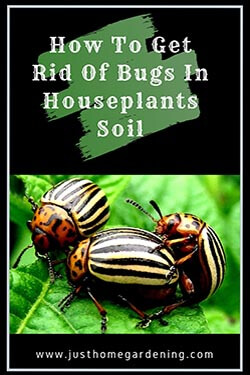 Getting tired of being bugged by the bug? Sorry, I just couldn't resist using that line! If you are thinking of how to get rid of bugs in houseplants soil you are at the right place. I wrote this article specifically to help you identify what type of bugs have attacked your houseplants and how to get rid of them effectively.
Getting tired of being bugged by the bug? Sorry, I just couldn't resist using that line! If you are thinking of how to get rid of bugs in houseplants soil you are at the right place. I wrote this article specifically to help you identify what type of bugs have attacked your houseplants and how to get rid of them effectively.
It's true that indoor container gardening is one of the most popular hobbies nowadays among urbanites. With not enough space for outdoor gardens, you have to make most out of your space to enjoy vibrant blooms & better air quality. But along with the enthusiasm and excitement also comes a serious challenge – Bugs!
From whiteflies to fungus gnats, aphids, thrips, and what-have-you, these minuscule creepy living things are collectively called "bugs" for a reason- they can bug you to no end causing distress not just to the plant itself but also to your sanity.
Let's get right to it, if you already know what type bugs have attacked you, click on the bug name in the table of contents below to jump right to the solution.
If you're unsure which type of bugs have infested your houseplant & soil, I still got your back. Keep reading below, this guide will help you identify & get rid of your bug infestation.
Table of Contents
- What are the common Houseplant Bugs?
- What parts of the Houseplants do Bugs attack?
- What are the Methods to get rid of Bugs in Houseplants & Soil?
- How to Get Rid Of Bugs in Houseplants & Soil?
- 1. Fungus Gnats
- 1.1 How to identify Fungus Gnats in houseplant soil?
- 1.2 Facts about Fungus Gnats
- 1.3 How to get rid of Fungus Gnats from Houseplants Soil?
- Method 1: Dry them out (physical removal)
- Method 2: Neem oil (natural treatment)
- Method 3: Diluted Hydrogen peroxide
- Method 4: BT (Bacillus thuringiensis) (natural treatment)
- Method 5: Cinnamon & Chamomile Tea (natural treatment)
- Method 6: Food Grade Diatomaceous earth (DE) (natural treatment)
- 2. Scale
- 2.1 How to identify Scale in houseplants & soil?
- 2.2 Facts about Scale Insects
- 2.3 How to get rid of Scales from Houseplants & Soil?
- Method 1: Stem Removal (physical removal)
- Method 2: Rubbing alcohol (household treatment)
- Method 3: Neem oil (natural treatment)
- 3. Spider Mites
- 3.1 How to identify Spider Mites in houseplants & soil?
- 3.2 Facts about Spider Mites
- 3.3 How to get rid of Spider Mites from Houseplants & Soil?
- Method 1: Cut Off Stems & Water Blaster (physical removal)
- Method 2: Neem oil or Insecticidal soap (natural treatment)
- 4. Aphids
- 4.1 How to identify Aphids in houseplants & soil?
- 4.2 Facts about Aphids
- 4.3 How to get rid of Aphids from Houseplants & Soil?
- Method 1: Manual Removal (physical removal)
- Method 2: Neem oil or Insecticidal soap (natural treatment)
- 5. Whiteflies
- 5.1 How to identify Whiteflies in houseplants & soil?
- 5.2 Facts about Whiteflies
- 5.3 How to get rid of Whiteflies from Houseplants & Soil?
- Method 1: Water Blasting (physical removal)
- Method 2: Neem Oil or Insecticidal Soap (natural treatment)
- 6. Mealybugs
- 6.1 How to identify Mealybugs in houseplants & soil?
- 6.2 Facts about Mealybugs
- 6.3 How to get rid of Mealybugs from Houseplants & Soil?
- Method 1: Wash off with Water (physical removal)
- Method 2: Neem Oil or Insecticidal Soap (natural treatment)
- 7. Thrips
- 7.1 How to identify Thrips in houseplants & soil?
- 7.2 Facts about Thrips
- 7.3 How to get rid of Thrips from Houseplants & Soil?
- Method 1: Water Blasting (physical removal)
- Method 2: Neem Oil or Insecticidal Soap (natural treatment)
- 1. Fungus Gnats
- How to prevent Bugs from infesting your Houseplants?
- Final Words
What are the common Houseplant Bugs?
There are many types of bugs that can attack your houseplants, here is the list of most common houseplant bugs –
- Fungus Gnats
- Scale
- Spider Mites
- Aphids
- Whiteflies
- Mealybugs
- Thrips
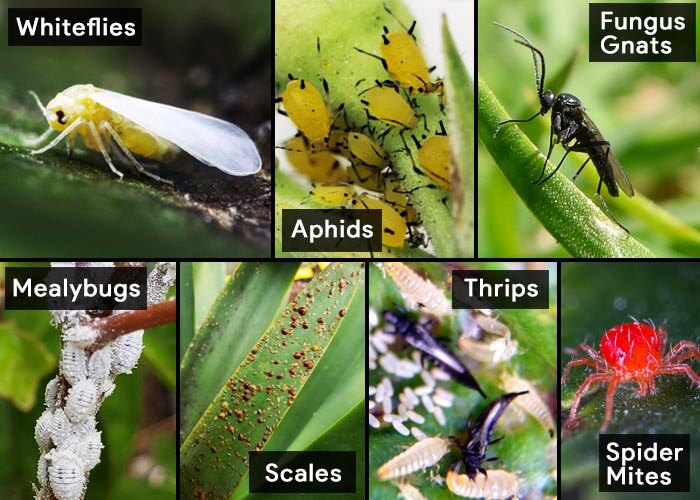
Carefully observe the type or types of bugs infesting your houseplants' soil. Gnats, for instance, can be seen after heavy watering while spider mites tend to infest in warm, dry conditions. Identifying what's infesting your potted plants will make the process of eradicating them more efficient and less time-consuming.
What parts of the Houseplants do Bugs attack?
Depending on the type of bug, they attack different parts of the plant.
Leaves
- Baby leaves (new growth, very vulnerable)
- Stems
- Buds
- Flowers
- Roots
Some crawl and feed on leaves, some live in the houseplant soil, some flies around while some just stick to the plant like a fungi. Regardless of which type of bugs have attacked your plants. It's of utmost importance to act quickly and get rid of them.
What are the Methods to get rid of Bugs in Houseplants & Soil?
1. Physical removal – Some pests big enough to see, you can just wash them off with water stream from a hose. For heavily infested stems or leaves you can just cut them off to stop the spread. Dispose of the cut stems & leaves safely far away from the plants.
2. Household Treatment for Houseplants – You can use 1 tbsp Mild liquid soap mixed with 1 liter of water to spray on the parts of the infested plants. The fatty acid in soap can break down the bug's outer shell and kill them. Keep the plant away from direct sunlight as it can increase the chances of sunburn.
3. Natural treatment* – Neem oil is certainly one of the best natural solutions. Mix as per instructions (usually 2 tbsp Neem oil + 2-3 tsp mild liquid soap + 1 gallon of water) and spray on your infected plants & houseplant soil. It has a bit of pungent smell but surely kills & chases your bugs off your plants. Alternatively, you can use horticultural oil or organic insecticidal soap spray many of which also contains neem oil.
Neem oil solution is the most effective natural treatment that we highly recommend against any kind of houseplant bugs.
4. Systemic treatment for Houseplants – This solution involves the usage of chemical insecticides to kill the bugs and pests infecting the soil & plants. It can be sprayed on the plants or mixed with water & poured on the soil. Read instructions carefully before using them. Overdosing can kill your plants. Plus, make sure chemical drops don't land on your skin as it can be harmful to humans. We do not recommend using this systemic method unless in extreme infestation cases.
NOTE
Whether you choose Soap, Neem oil, Insecticidal Soap, or Chemical insecticides to treat your plants, only spray when weather is cool, early morning or before sunset. Do not spray plants in sunlight as it can have harmful effects on your plants.
How to Get Rid Of Bugs in Houseplants & Soil?
1. Fungus Gnats
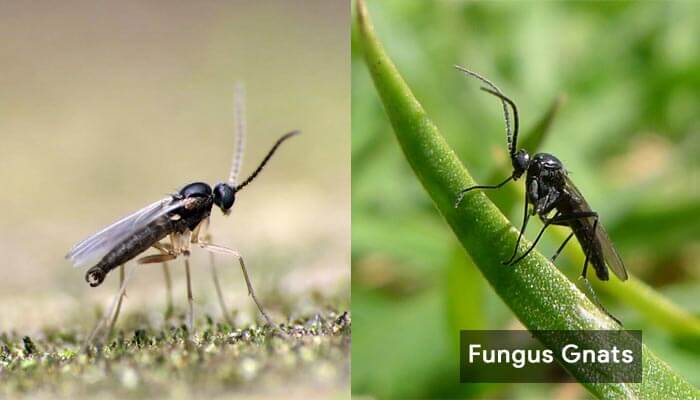
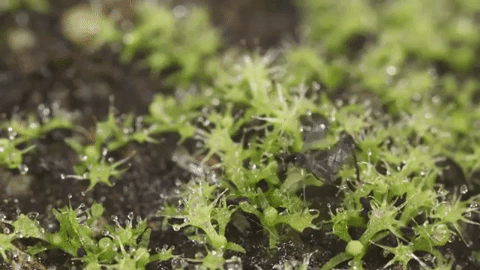
1.1 How to identify Fungus Gnats in houseplant soil?
- Black insects, look like tiny mosquitoes or flies
- They've narrow legs & transparent wings
- Can fly around but stays close to the food source (fungi) in soil
- Adult gnats live about few days to a week
- Larvae look like long white or gray worms
- To check for infestation, shake the pot, if you see tiny flies scattering in swarms, its most likely fungus gnats
1.2 Facts about Fungus Gnats
- Fungus Gnats are mainly result of overwatering the plants
- Thrives & breeds in humid damp soil
- Cannot live long without water or moisture
- Reproduces quickly, lays egg in moist soil
- Lay ~300 eggs in a batch, hatches in 3 days, matures in 3 weeks
- Primarily eat fungi growing on damp soil
- Adult gnats are not very harmful to plants
- Their larva is most dangerous as they can feed on plant roots or root hairs
- This interrupts and hampers the plants ability to absorb nutrients & slows growth
- Causes plants to wilt
Difference between Fungus Gnats & Fruit Flies
– Black bugs, lurking & flying around plant soil are Fungus Gnats
– Bugs roaming around fruits or the garbage bin are Fruit flies
1.3 How to get rid of Fungus Gnats from Houseplants Soil?
The first step would be to isolate the infested plants from your other plants. I recommend to try out method 1 & 2 first, in conjunction with Method 6. This combined approach is usually enough to get rid of all fungus gnats for good. If infestation persists, look into the other methods.
Method 1: Dry them out (physical removal)
Stop watering the plant for a few days and dry out 1.5 inches from the top layer of the soil, this will kill most of the bugs (no treatment method). However, you can still water the plants from the bottom through the draining hole.
You can do that by pouring sufficient water into the saucer (water collector), sit the pot on it for 30 mins and then through away any remaining water. This way, the plant will get its required water though its deeper roots, while soil on top will continue to dry out killing the gnat larvae & eggs.
TIP
Dig up few centimeters from the upper layer of the soil, it will expose the gnat eggs & larvae and help dry the soil faster.
Method 2: Neem oil (natural treatment)
Pour neem oil or insecticidal soap solution (natural treatment) on the top part of the houseplant soil and spray the area thoroughly. For Neem solution, use 2 tbsp Neem oil + 2-3 tsp mild liquid soap + 1 gallon of water. Neem spray will kill and repel gnats as well. Apply treatment once every week, for 2-3 weeks.
Products you need for Neem oil method:
| Product | Link |
|---|---|
| Organic Neem Oil | Check on Amazon |
| Mild liquid soap (Castile soap) | Check on Amazon |
Method 3: Diluted Hydrogen peroxide
If infestation persists, dry the top layer of soil. Then make a solution of 1 part "3% hydrogen peroxide" and 4 parts "Water", let it rest for 30 minutes. Water your plants with it. Hydrogen peroxide solution will kill any Gnat larva or eggs in the soil.
The hydrogen peroxide mixture also helps kill any harmful bacteria and emerging fungi. Repeat this treatment once every week, for 2-3 weeks if needed.
Products you need for Hydrogen peroxide method:
| Product | Link |
|---|---|
| Hydrogen Peroxide | Check on Amazon |
Method 4: BT (Bacillus thuringiensis) (natural treatment)
BT is a natural occurring, soil-borne bacteria which does not harm human or pets. Take a few tbsp of BT & dilute with a gallon of water, leave the solution to infuse for at least a couple of days. Water the plants weekly with it, this will kill the gnats. Continue this treatment once a week, for 2-3 weeks if needed.
Products you need for BT method:
| Product | Link |
|---|---|
| Bacillus thuringiensis Liquid | Check on Amazon |
Method 5: Cinnamon & Chamomile Tea (natural treatment)
Just sprinkle a thin layer of cinnamon powder over the top layer of the houseplant soil. This actually kills the fungus that the larvae feed on, starving them to death. Repeat the sprinkling once every week, for 2-3 weeks.
Alongside sprinkling cinnamon, use Chamomile Tea to make the treatment stronger. Use 4 tbsp chamomile leaf to brew 32oz of tea, once cooled, mix it with 1 gallon of water. Use it to water the plants regularly, monitor regularly, and see if the gnats are dead within 2-3 weeks.
Products you need for Cinnamon-Chamomile method:
| Product | Link |
|---|---|
| Ground Cinnamon | Check on Amazon |
| Chamomile Herbal Tea | Check on Amazon |
Method 6: Food Grade Diatomaceous earth (DE) (natural treatment)
DE is a fossilized shards of aquatic organisms that can kill fungus gnats by absorbing their oils and damaging their bodies with its sharpness. Dry out the top layer of the soil and add a layer of food-grade DE on top of the soil. I recommend wearing a mask while working with DE. Repeat the process once a week, for 3 weeks if needed.
Products you need for Diatomaceous Earth method:
| Product | Link |
|---|---|
| Food Grade Diatomaceous earth | Check on Amazon |
| Organic Cocopeat | Check on Amazon |
Method 7
Along with any of the methods above, use Yellow Sticky Traps (check on Amazon) to kill adult gnats. This will severely reduce their population and eventually clean them out effectively.
TIP
Once you get rid of Fungus Gnats, use "soil cover" to cover the top part (about 1/4″-1/2″) of your soil so that gnats cannot come back and breed. You can use Desert sand, Gravels, or my best choice Cocopeat which comes with a lot of additional benefits.
2. Scale
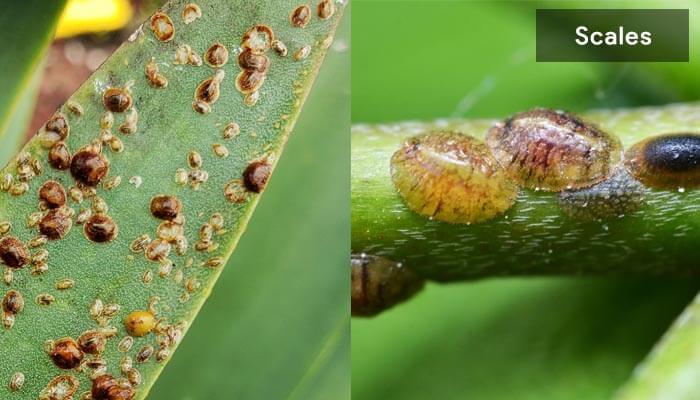
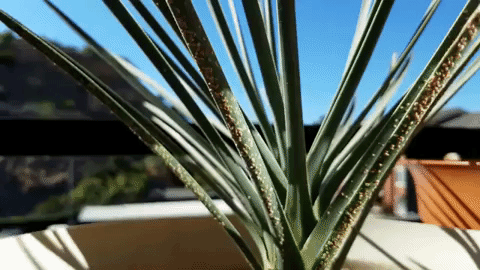
2.1 How to identify Scale in houseplants & soil?
- Tiny round or oval-shaped bugs, looks like small shell or bumps
- Varies in color, can be black, white, gray, brown, red, etc.
- Can be 1/16″ to 3/8″ in size
- Usually found in clusters on stems, joints & leaves
- Barely visible in egg & nymph stages
- There're 2 types of scale: i) soft & ii) armored scale
- Soft scale: covered with a waxy substance, easier to kill
- Armored scale: covered with a hard protective shell, difficult to kill, even with insecticides
- As they feed, they excrete and leave "honeydew", that is one sign of scale infestation
- If you see a group of "not moving" or stiff bumps on the plant, its most likely Scales
- You may also find them crawling or hiding in the houseplant soil and near roots
2.2 Facts about Scale Insects
- Scale eggs are protected by the female under the shell
- Eggs take 2-3 weeks to hatch (nymphs), then takes 6-9 weeks to mature
- Reproduces even quicker on indoor houseplants than outdoors
- They pierce & lock into the plant and feeds on plant sap
- Causes growth to stun, deformed leaves, yellowing & leaves fall off
- Difficult to get rid of, adult scales attach themselves very firmly to stems
- The "nymph" stage is the best time to kill Scales as it's their most vulnerable time
2.3 How to get rid of Scales from Houseplants & Soil?
Separate the infected plants from all other plants to prevent any scales from transferring to neighboring plants. In most moderate infestation cases, Method 3 is very effective and will get rid of the scales, so I recommend trying it out first.
Ineffective treatment
Since scales lock themselves on the plant, they cannot be washed off easily with a water stream. Furthermore, insecticidal soap treatment is not very useful against these bugs either, because the solution cannot get inside effectively through their hard shells.
Method 1: Stem Removal (physical removal)
If you spot scales in early stages, just prune off the stems & leaves with a pair of shears. Keep an eye on the plants for 2-3 weeks to make sure there are no more of them appearing.
| Product | Link |
|---|---|
| Pruning Shears | Check on Amazon |
Method 2: Rubbing alcohol (household treatment)
Use cotton swabs or pads dipping in rubbing alcohol (containing 68%-72% isopropyl alcohol) and wipe over the scales plugged to the stems. The scales will not fall off right away, but the alcohol will kill the scales. Wipe over all affected stems. Check & repeat the treatment once a week, for 2-3 weeks. That should be get rid of scales from your houseplants.
Products you need for Rubbing alcohol method:
| Product | Link |
|---|---|
| Rubbing alcohol | Check on Amazon |
| Cotton Swabs | Check on Amazon |
| Cotton Rounds | Check on Amazon |
TIP
It's better to use cotton swabs than cotton pads as you can precisely touch the scales with minimum alcohol contact to stem & leaves.
Method 3: Neem oil (natural treatment)
While the alcohol method helps get rid of most scales, a few may be hiding in the soil, edges of the pot, and can reproduce the infestation. Mix 2 tbsp Neem oil, 2-3 tsp mild liquid soap, 1 gallon of water to make a natural insecticide.
Spray the neem insecticide onto the soil and also pour some on the soil. Spray the plant from all angles. Repeat the treatment once every week, for 2-3 weeks. This will get rid of the remaining scales and keep them away.
Products you need for Neem oil method:
| Product | Link |
|---|---|
| Organic Neem Oil | Check on Amazon |
| Mild liquid soap (Castile soap) | Check on Amazon |
3. Spider Mites
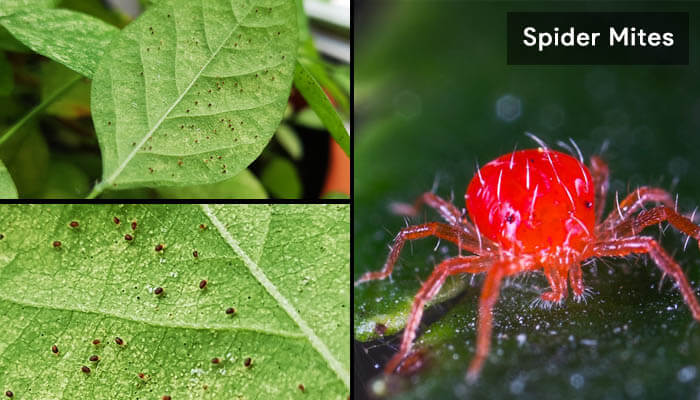
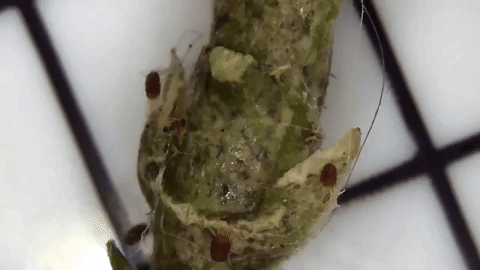
3.1 How to identify Spider Mites in houseplants & soil?
- Looks like very tiny spiders
- Hardly visible without a magnifying glass
- Closely related to spiders than any other bugs
- Loves warm & dry houses
- They can be black, red, white, light brown, green or yellow in color
- You are likely to also find fine white webs covering parts of your plants
- Spider mites start webbing from under the leaves & are difficult to notice at early stages
- Webs are practically the telltale that your plant has been infested by spider mites
- To actually see them, take a white paper underneath and shake an infested stem or leaf
- You should notice tiny dots on the paper, moving slowly
3.2 Facts about Spider Mites
- Reproduces quickly, eggs hatch in few days
- Take 1 week to mature, population doubles bi-weekly
- Spider mites don't live in the houseplant soil, but can roam around & hide in the edges
- Very hazardous to plants, they suck sap out from stems & foliage
- Infected leaves will be speckled, show spots, appear discolored and can curl up
- Leaves can eventually dry up fall off, this can eventually kill the plant if left untreated
3.3 How to get rid of Spider Mites from Houseplants & Soil?
Quarantine the attacked plant immediately for treatment, to make sure the bugs do not pass over to other houseplants. I recommend using both Method 1 & 2, one after the other, that is usually effective enough to get rid of spider mites from your houseplants.
Method 1: Cut Off Stems & Water Blaster (physical removal)
First cut off any heavily infested branches or stems from the plant. Put them immediately in a ziplock bag or a garbage bag so these bugs can't escape. Use water stream from a hose to spray plants from all angles to fend off as many mites as possible. Preferably take the plant outside to do this. This method will work for light infestation only.
| Product | Link |
|---|---|
| Pruning Shears | Check on Amazon |
Method 2: Neem oil or Insecticidal soap (natural treatment)
Spray the plant with insecticidal soap or Neem oil solution once weekly, for 2-3 weeks to kill all eggs & remaining bugs. For Neem solution combine 2 tbsp Neem oil, 2-3 tsp mild liquid soap, 1 gallon of water.
Spray the solution over the soil & pour some on the soil if you find too many mites crawling or just to be extra safe. Chemical insecticides (systemic treatment) are not recommended as they quickly gain tolerance.
Products you need for Neem oil method:
| Product | Link |
|---|---|
| Organic Neem Oil | Check on Amazon |
| Mild liquid soap (Castile soap) | Check on Amazon |
4. Aphids
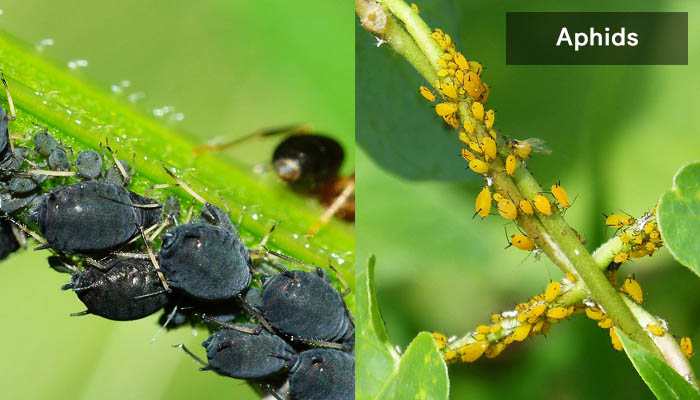
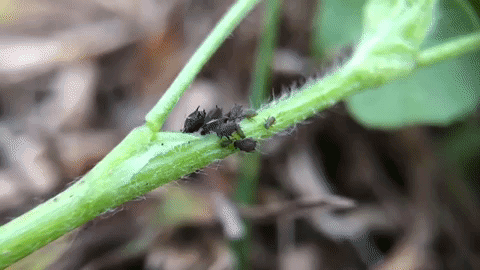
4.1 How to identify Aphids in houseplants & soil?
- Very tiny pear-shaped bugs, usually less than 1/4″ in size
- Has long antennas
- Born in various colors – black, yellow, greenish, pink, brown or red, etc.
- Some can fly, most can't
- Most species have 2 pointy needles on their back
- Nymphs and adults look similar
- Hard to notice until the population has exploded
- If you notice leaves curling, covered with sticky stuff and a swarm of tiny dots scattered under the leaves or stems, then your houseplant is infested by Aphids
4.2 Facts about Aphids
- Excretes "honeydew" which can result in molding
- In winter they lay eggs in the soil, in the warmer season they lay eggs on leaves
- Reproduces very fast (asexual) & form a large population.
- Aphids pierce through stems with their pointy needle and suck on sugar-rich plant sap.
- Injects it's saliva while feeding & spread diseases
- Causes plant to wither, deform new growth, leaves to curl and wounds do not heal easily.
4.3 How to get rid of Aphids from Houseplants & Soil?
Isolate the plant away from all your other plants to prevent the spread of the aphids. I recommend executing Method 1 and then apply Method 2 choosing Neem oil as it's the most effective of natural organic insecticides from my experience.
Method 1: Manual Removal (physical removal)
For lightly affected stems & leaves, spray off the aphids with a stream of water from a hose. For badly infested leaves & stems, prune it off with a garden shear.
| Product | Link |
|---|---|
| Pruning Shears | Check on Amazon |
Method 2: Neem oil or Insecticidal soap (natural treatment)
Spray the aphids with insecticidal soap solution or organic fertilizer like neem oil solution. To prepare Neem solution mix 2 tbsp Neem oil, 2-3 tsp mild liquid soap, and 1 gallon of water. Pour some Neem solution on the houseplant soil to make sure any hidden eggs or aphids are eradicated. If you choose insecticidal soap, wipe the Aphids off with a cloth soaked in organic insecticidal soap. Repeat the treatment for every few days for 2 weeks.
TIP
Make sure to spray underside of the leaves as aphids can be feeding there.
If the infestation continues heavily, only then look into using chemical insecticide (systemic treatment) to kill them. Note that when using systemic treatment, it can harm friendly creatures like hummingbirds, bees, etc. But that mainly applies to outdoor plants.
Products you need for Neem oil method:
| Product | Link |
|---|---|
| Organic Neem Oil | Check on Amazon |
| Mild liquid soap (Castile soap) | Check on Amazon |
| Natria Insecticidal Soap (alternate option to neem) | Check on Amazon |
5. Whiteflies
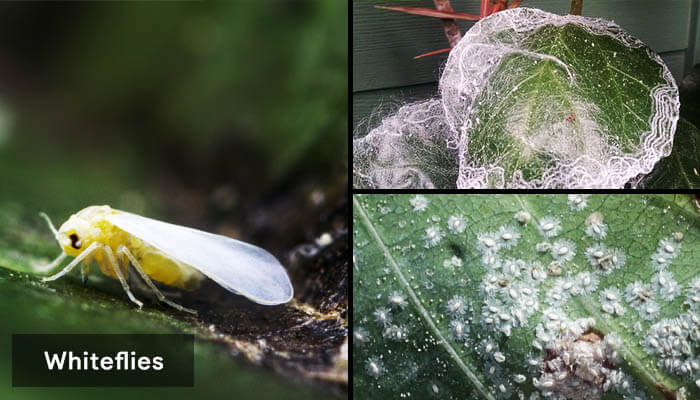
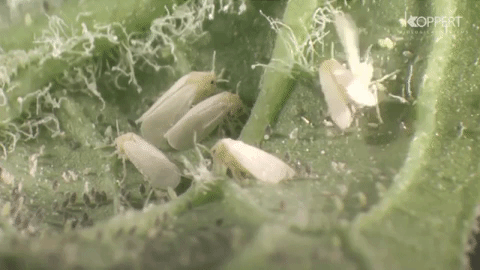
5.1 How to identify Whiteflies in houseplants & soil?
- Tiny white moth-like bugs.
- 1/8″ to 1/10″ long at most
- White or slightly yellowish in color
- Have wings and can fly
- Usually found under the leaves of houseplants
- Can move or fly off very quickly, so you cannot physically catch or kill them
- Turn over and shake the houseplant leaves to visually check. If you see a gathering of white bugs matching the description above are flying off, your plant is infested with whiteflies.
5.2 Facts about Whiteflies
- Cannot survive in freezing temperatures
- Usually lay white eggs under the leaves & soil
- Can reproduce quickly in warm weather and indoors
- Attacks in swarms, very harmful to the plant
- Nymph and adult whiteflies are most harmful to houseplants
- Their feeding leaves off a sticky substance also known as "honeydew"
- Honeydew can result in the development of mold
- Honeydew also calls for another danger, Ants
5.3 How to get rid of Whiteflies from Houseplants & Soil?
Whiteflies can spread fast and it's very important to get rid of them quickly. First move away the infested plant to a separate location.
Start treatment with Method 1, follow up with Method 2, use Neem oil solution to execute this step. Alongside, setup Method 3 to kill adult flies at the same time. These 3 methods combined will effectively get rid of the whiteflies for good.
Method 1: Water Blasting (physical removal)
First try shedding off the eggs with a stream from a water hose. Fire from all angles to wash out as many bugs & eggs as possible.
Method 2: Neem Oil or Insecticidal Soap (natural treatment)
Spray over & under the leaves with Neem oil or Insecticidal Soap solution. To make the Neem solution mix 2 tbsp Neem oil, 2-3 tsp mild liquid soap, and 1 gallon of water. The neem will keep any adult whiteflies away. Do that once every week or few days, for 2-3 weeks. Carry on treatment a week longer if the infestation persists.
Products you need for Neem oil method:
| Product | Link |
|---|---|
| Organic Neem Oil | Check on Amazon |
| Mild liquid soap (Castile soap) | Check on Amazon |
| Natria Insecticidal Soap (alternate option to neem) | Check on Amazon |
Method 3 (physical removal)
Along with any of the methods above, Use Yellow sticky traps (check on Amazon) at the same time to kill flying adult whiteflies & lower their numbers quickly.
Avoid using chemical insecticides (systemic treatment) as whiteflies usually gain quick resistance.
6. Mealybugs
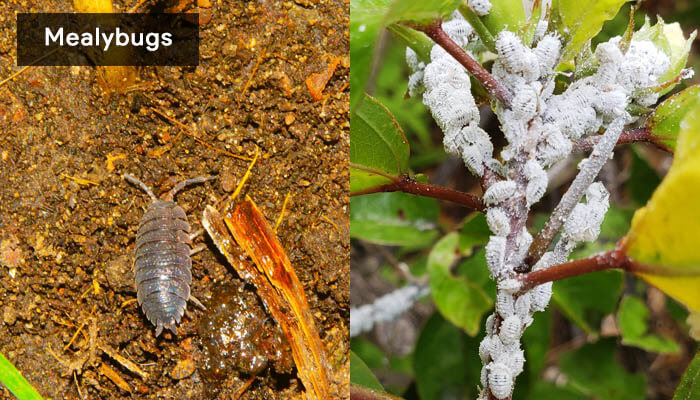
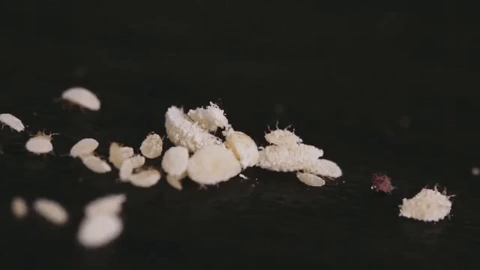
6.1 How to identify Mealybugs in houseplants & soil?
- White soft, spongy, cottony looking bugs
- Sometimes mistaken as fungus
- Moves slowly, can't fly
- Part of the "soft" scale family
- Can live in houseplant soil and feed on new roots
- Gather at leaf joints, stems or underside of the leaves
- If you see these sticky, white, spongy bugs clustering around leaves/stems, and slightly move when poked, your houseplants are infected with mealybugs.
6.2 Facts about Mealybugs
- Reproduces slowly and takes 7-10 weeks to mature
- Outer coat of mealybugs can protect them from insecticides & water
- They suck on plant sap causing leaves to fall off, turn yellow and results in deformed growth
- Plants can die if left untreated for a long time
6.3 How to get rid of Mealybugs from Houseplants & Soil?
Take the infected plants and quarantine them away from any other plants, this is to stop the mealybugs from finding their way to neighboring plants. I recommend to use both Method 1 & Method 2 to permanently get rid of Mealybugs.
Method 1: Wash off with Water (physical removal)
Wash them off with a water stream from a hose, this works for light infestation. Repeat this regularly for few days and see they are coming back. If they come back, use method 2.
Method 2: Neem Oil or Insecticidal Soap (natural treatment)
Use Insecticidal soap or Neem oil spray for moderately or heavily infested plants. Make Neem insecticide by mixing 2 tbsp Neem oil, 2-3 tsp mild liquid soap and 1 gallon of water. Make sure to check & spray the plant from all sides as mealybugs can hide in various cervices.
Mealybugs can also hide under the soil, so dig up the top layer of soil and check. To be on the safe side, pour some Neem solution on the soil so it destroys any bugs hidden under the houseplant soil. Repeat the treatment once a week, for 2-3 weeks.
If the infestation not under control in 3 weeks, consider getting rid of the plant as it can infect others.
Products you need for Neem oil method:
| Product | Link |
|---|---|
| Organic Neem Oil | Check on Amazon |
| Mild liquid soap (Castile soap) | Check on Amazon |
| Natria Insecticidal Soap (alternate option to neem) | Check on Amazon |
7. Thrips
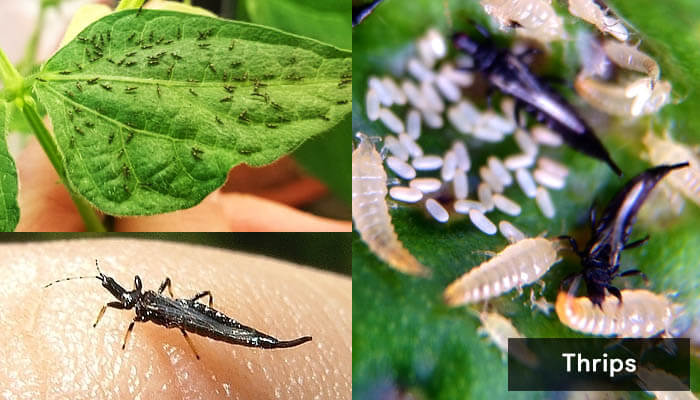
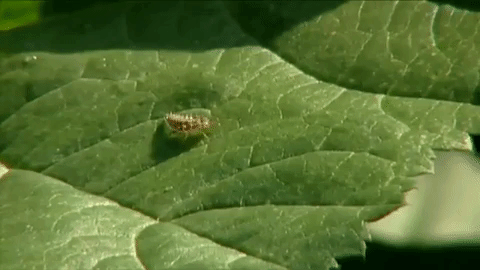
7.1 How to identify Thrips in houseplants & soil?
- Nearly invisible, hard to spot
- Usually black or brown in color
- Can vary in color, like white, light yellow, greenish, etc.
- Have narrow wings and can fly
- You can spot their dropping which are like black dots on leaves.
- Use a magnifying glass to check or shake them off onto a piece of white paper to see & identify them.
7.2 Facts about Thrips
- Lay eggs in the soil & can reproduce very quickly
- Adult thrips can live up to a month
- Usually starts feeding from under the leaves, makes them hard to spot in the early stage.
- Sucks and feed on plant juices out of leaves, stems, or flowers.
- Causes plant to droop, mark black spots on leaves or form white patches.
- Color of the leaves will fade to pale, then eventually brown and fall off.
- New growth can be deformed by thrips.
7.3 How to get rid of Thrips from Houseplants & Soil?
Isolate the affected plants immediately. I recommend using both Method 1 and then Method 2 one after the other. Plus use Method 3 in parallel to get rid of adult Thrips as well.
Method 1: Water Blasting (physical removal)
Use water stream from a hose to wash off affected areas.
Method 2: Neem Oil or Insecticidal Soap (natural treatment)
Make Neem insecticide by mixing 2 tbsp Neem oil, 2-3 tsp mild liquid soap & 1 gallon of water. Spray the solution all over the plants, including the top layer of the soil. Repeat the process once every week for 2-3 weeks.
Products you need for Neem oil method:
| Product | Link |
|---|---|
| Organic Neem Oil | Check on Amazon |
| Mild liquid soap (Castile soap) | Check on Amazon |
| Natria Insecticidal Soap (alternate option to neem) | Check on Amazon |
Method 3
At the same time, place Yellow Sticky Traps close to the plant. Thrips are attracted to bright colors and that can be used to trap them. Adult Thrips will jump, get stuck to the cards, and die.
How to prevent Bugs from infesting your Houseplants?
No doubt prevention is better than cure when it comes to bug annoyance!
1. Keep your plants healthy
Lack of care in the following aspects can weaken your plants & make them vulnerable to houseplant bugs
- Improper watering, too much or too little water can harm the plant.
- Lack of light or too much light. Learn how much light your plants need, different plants have different light requirements.
- Lack of Humidity.
- Over or underuse of fertilizers can affect your plant's health. Too much can even kill your plants.
- Sudden temperature change, don't bring your plants from a very hot to very cool place. Or vice versa.
So, it's very important to know the conditions in which your plants will thrive and stay healthy.
2. Clean your Pots effectively
- Wash your pot or container with warm water and soap before potting your plant.
- This ensures there are no bug eggs or invisible pests left living in it.
3. Sterilize your soil to get rid of bug eggs
- Even potting soil purchased from a nursery can sometimes have insect or bug eggs living in it.
- Mix some Neem cake fertilizer to your soil mix to take care of this.
- Not only this is a great fertilizer, but it will also kill & repel many soil-borne bugs, insects, or fungi.
- Keep any extra potting soil in an airtight bag.
4. Keep an eye on your Plants
- Watch your plants closely on a regular basis.
- Check for signs of pests/bugs especially on new baby leaves, over and underside of the leaves & any clutters on the stems or joints.
- Also dig on the far end of the pot until you can see some roots. Healthy roots will usually feel firm and look whitish in color. Read more about root health here.
- Taking early action will help get rid of houseplant bugs much more easily than when the infestation gets widespread.
TIP
Baby leaves or new growth are the most vulnerable & favorite meals for bugs. Monitor your new growth closely, especially in spring as its a prime time for new growth. If you notice any bugs, wash them off with water immediately.
5. Disinfect your Garden tools
- It's important to disinfect your tools before using on another plant
- Not cleaning your tools can transmit diseases from one plant to another
- You can use a clean cloth soaked in 70% isopropyl alcohol and simply wipe the blades of your shears, pruners, etc.
- You can learn more about cleaning gardening tools here.
6. Quarantine New & Sick plants
- Keep any newly bought plants separately for a while, make sure its bug free.
- Spray the new plants with organic insecticide lightly just to make sure any bugs will die or flee away before putting it with the rest of the plants.
- If you see any plants getting sick, quarantine them in a separate place. Treat them with proper meds or insecticide until they get well.
7. Be careful when bringing Plants Indoor
- Before you bring your plants inside, for example at the end of summer, wash them with water thoroughly to get rid of any bugs.
- You can also spray the plants lightly with organic insecticide anyways to make sure there are no bugs coming in with the plants.
8. Introduce helpful Bugs
You can introduce helpful predatory bugs to your plants. For example- pirate bugs, lacewings, and ladybugs feed on harmful bugs and get rid of them naturally. This approach is mainly for outdoor plants.
Final Words
No matter which of bugs has infested your houseplants' soil, you now have the clear steps to identify them and follow the effective methods to get rid of them completely.
Remember, the Neem oil solution works with almost all other types of bugs as well. It's an organic, natural & very effective treatment to get rid of bugs in houseplants & soil.
A final tip
I regularly spray all my plants with Neem Oil solution every couple of weeks to keep the bugs away for good. Bugs really do hate Neem!
I hope, empowered with the knowledge from this guide, you will be able to win the battle and stop the bugs from bugging you!
Summary
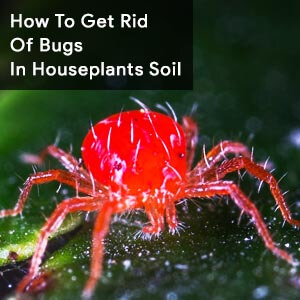
Article Name
How To Get Rid Of Bugs In Houseplants Soil
Description
Learn how to get rid of bugs in houseplants soil. This guide will help you eradicate houseplant bugs in the most effective & natural ways.
Author
Raymond Kartzman
Publisher Name
Just Home Gardening
Publisher Logo

How to Get Rid of Little Black Bugs in Houseplants
Source: https://www.justhomegardening.com/how-to-get-rid-of-bugs-in-houseplants-soil